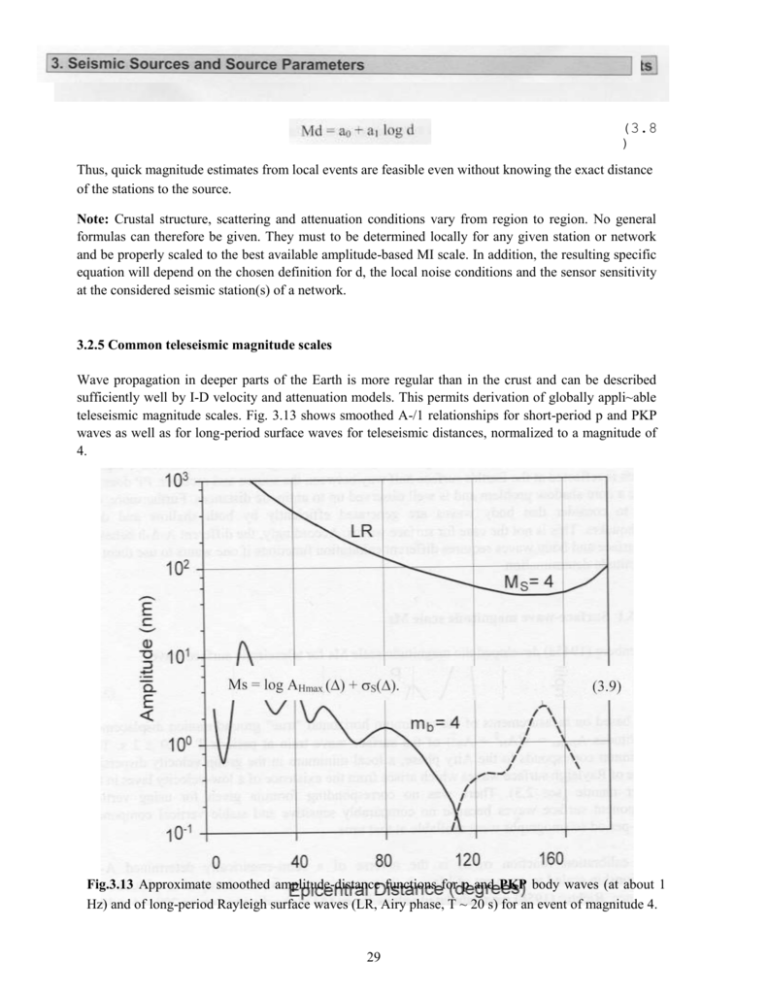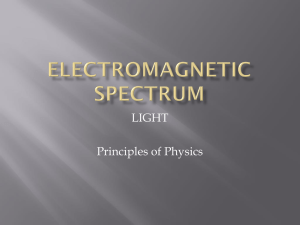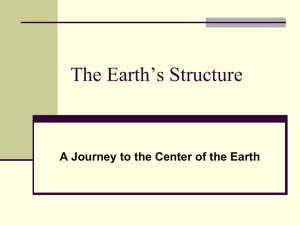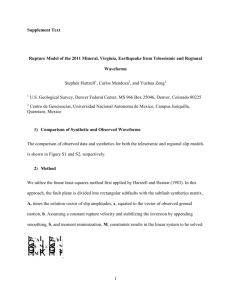Discussion of MS magnitude computation
advertisement

(3.8 ) Thus, quick magnitude estimates from local events are feasible even without knowing the exact distance of the stations to the source. Note: Crustal structure, scattering and attenuation conditions vary from region to region. No general formulas can therefore be given. They must to be determined locally for any given station or network and be properly scaled to the best available amplitude-based MI scale. In addition, the resulting specific equation will depend on the chosen definition for d, the local noise conditions and the sensor sensitivity at the considered seismic station(s) of a network. 3.2.5 Common teleseismic magnitude scales Wave propagation in deeper parts of the Earth is more regular than in the crust and can be described sufficiently well by I-D velocity and attenuation models. This permits derivation of globally appli~able teleseismic magnitude scales. Fig. 3.13 shows smoothed A-/1 relationships for short-period p and PKP waves as well as for long-period surface waves for teleseismic distances, normalized to a magnitude of 4. Fig.3.13 Approximate smoothed amplitude-distance functions for p and PKP body waves (at about 1 Hz) and of long-period Rayleigh surface waves (LR, Airy phase, T ~ 20 s) for an event of magnitude 4. 29 From Fig. 3.13 the following general conclusions can be drawn: surface waves and body waves have a different geometric spreading and attenuation. While the former propagate in two dimension only, the latter spread three- dimensionally. Accordingly, for shallow seismic events of the same magnitude, surface waves have generally larger amplitudes than body waves; surface wave amplitudes change smoothly with distance. They generally decay up to about 140° and increase again beyond about 150°-160°. The latter is due to the increased geometric focusing towards the antipode of the spherical Earth's surface which then overwhelms the amplitude decay due to attenuation; in contrast to surface waves, the A-Delta relations for first arriving longitudinal waves (P and PKP) show significant amplitude variations. The latter are mainly caused by energy focusing and defocusing due to velocity discontinuities in deeper parts of the Earth. Thus the amplitude peaks at around 20° and 40° are related to discontinuities in the upper mantle at 410 km and 670 km depth, the rapid decay of short-period p- wave amplitudes beyond 90° is due to the strong velocity decrease at the core- mantle boundary ("core shadow"), and the amplitude peak for PKP near 145° is caused by the focusing effect of the outer core (see Fig. 11.59). Other body wave candidates for magnitude determinations again behave differently, e.g. PP which is reflected at the Earth's surface halfway between the source and receiver. pp does not have a core shadow problem and is well observed up to antipode distances. Furthermore, one has to consider that body waves are generated efficiently by both shallow and deep earthquakes. This is not the case for surface waves. Accordingly, the different A-Delta-h behavior of surface and body waves requires different calibration functions if one wants to use them for magnitude determination. 3.2.5.1 Surface-wave magnitude scale Ms Gutenberg (1945a) developed the magnitude scale Ms for teleseismic surface waves: It is based on measurements of the maximum horizontal "true" ground motion displacement amplitudes AHmax = Sqrt(AN**2 + AE**2) of the surface wave train at periods T = 20 + 2 s. This maximum corresponds to the Airy phase, a local minimum in the group velocity dispersion curve of Rayleigh surface waves which arises from the existence of a low-velocity layer in the upper mantle (see 2.3). There was no corresponding formula given for using vertical component surface waves because no comparably sensitive and stable vertical component long-period seismographs were available at that time. The calibration function sigmas(Delta) is the inverse of a semi-empirically determined A-Deltarelationship scaled to an event of Ms = 0, thus compensating for the decay of amplitude with distance. Richter (1958) gave tabulated values for sigmas(Delta) in the distance range 20° < I < 180° (see Table 3 in DS 3.1). This relationship was further developed by Eastern European scientists. Soloviev (1955) proposed the use of the maximum ground particle velocity (A/T)max instead of the maximum 30 Note 4: There may be significant regional biases due to surface-wave path effects. Lateral velocity variations in the crust and upper mantle as well as refraction at plate boundaries may result in significant focusing and de-focusing effects and related regional over- or underestimation of Ms (Lazareva and Yanovskaya, 1975). According to Abercrombie (1994) 31






